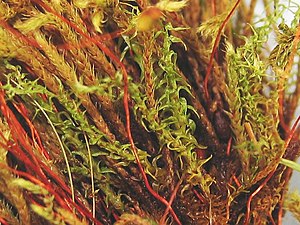Many-flowered gold sleep moss
| Many-flowered gold sleep moss | ||||||||||||
|---|---|---|---|---|---|---|---|---|---|---|---|---|

Campylium polygamum sprinkled between other mosses |
||||||||||||
| Systematics | ||||||||||||
|
||||||||||||
| Scientific name | ||||||||||||
| Campylium polygamum | ||||||||||||
| ( Schimp. In BSG ) CEO Jensen |
The many-flowered golden sleep moss ( Campylium polygamum ) is of particular importance as an indicator for bog areas. In some federal states it is on the red list.
Identifying features
Campylium polygamum is mainly characterized by its sparsely protruding leaves. The upright moss forms loose, yellowish green to golden brown lawns. Its stems, up to 10 cm long, have irregular branches. The elongated eilanzettlichen leaves are gradually narrowed to a point and are up to 3 mm long. The lamina cells are elongated and rectangular and are about 40 to 60 µm long and 10 to 15 µm wide. These are mostly clearly spotted near the leaf base. The leaf wing cells, which are often tanned and run down from the leaf, are puffed up, thick-walled and mostly spotted. There is a risk of confusion with Drepanocladus aduncus , which however never has spotted cells.
Occurrence
The moss colonizes light, base-rich, nutrient-poor, moist to wet low and intermediate bogs. It can also be found over peat and other dead plant parts. It rarely occurs on overground rock. Typical accompanying mosses are Calliergonella cuspidata and Bryum pseudotriquetrum . The species is distributed throughout Europe to Central Asia, parts of America and Australia. The moss occurs very often in particularly small populations and is particularly threatened by the destruction of its swell-boggy locations. Outside the Alps it is quite rare in Germany.
Sources and further information
literature
- Wolfgang Frey , Jan-Peter Frahm , Eberhard Fischer, Wolfram Lobin : The moss and fern plants of Europe (= small cryptogam flora. Vol. 4). Gustav Fischer, Stuttgart et al. 1995, ISBN 3-437-30756-8 .
- Martin Nebel, Georg Philippi (ed.): The mosses of Baden-Württemberg. Volume 2: Special part, (Bryophytina II, Schistostegales to Hypnobryales). Ulmer, Stuttgart 2001, ISBN 3-8001-3530-2 .
